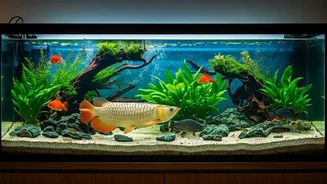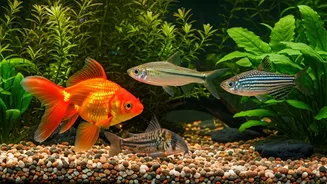Introduction to Large Fish
Aquarium keeping can range from the small and simple to the vast and complex, and the choice of fish dictates the requirements of the tank. For some, the allure
of large, impressive fish is strong. However, these fish have specific needs that smaller species do not, mainly related to space. Housing large fish in inadequate environments can lead to stress, stunted growth, and various health problems. Therefore, prospective fishkeepers must understand the needs of their chosen species, and this is especially important when considering the giants of the freshwater world. The initial expense of a larger tank is just the beginning. Maintaining the water quality of a spacious environment demands a robust filtration system, as well as more regular maintenance routines. Furthermore, the fish's natural behaviours must also be considered. Large fish typically require more swimming space and a diverse environment to prevent boredom and stimulate their instincts. Hence, deciding to keep such a fish requires more than just an appreciation for their beauty – it demands thorough research, dedication, and the willingness to provide a suitable habitat.
Oscar Fish's Needs
Oscar fish, scientifically known as *Astronotus ocellatus*, are a popular choice among experienced aquarists due to their intelligence and distinctive personalities. They can grow up to 12-14 inches (30-36 cm) in length, necessitating a large tank; a minimum of 75 gallons is recommended for a single adult, with a larger tank being preferable, especially for multiple fish. Oscars are known to be messy eaters, so powerful filtration is a must. They also require frequent water changes to maintain optimal water quality. These fish are known to rearrange their environment, so secure decorations are essential. They thrive in a well-decorated tank with plenty of hiding places, such as driftwood and rocks, which help them feel secure and enrich their habitat. Oscars are also known for their varied diet, including both live and prepared foods, which will need to be provided to ensure health. Because of their needs, Oscars are generally considered unsuitable for beginners.
Arowana: A Majestic Fish
The Arowana, often referred to as the dragon fish, is another large freshwater species that captivates aquarists with its graceful movements and impressive size. These fish can reach up to 36 inches (90 cm) in length, which requires a substantial tank—at least 125 gallons for a juvenile and even larger for a fully grown adult. Arowanas are jumpers, so a secure, tightly sealed lid is critical to prevent them from leaping out of the tank. They are primarily carnivorous, and their diet consists of live or frozen foods, such as insects and small fish. Arowanas prefer warm water, ideally between 75-86°F (24-30°C). They also benefit from a slightly acidic to neutral pH level. Due to their size, specific dietary needs, and sensitivity to water parameters, Arowanas are best suited for experienced fishkeepers. Their long lifespan also requires a long-term commitment to their care.
Giant Gourami's Requirements
Giant Gouramis (*Osphronemus goramy*) are another species that can grow exceptionally large, often reaching over 2 feet (60 cm) in length in the right conditions. Given their size, these fish demand expansive tanks or even outdoor ponds to ensure they have enough space to swim and exhibit their natural behaviours. It’s important to remember that these are territorial fish. Therefore, keeping only one in a tank is generally advisable, or they must be kept with other, equally sized fish. They are omnivores, consuming both plant and animal matter. They can be fed a varied diet, including commercial fish food, vegetables, and insects. Maintaining water quality is crucial; regular water changes and a robust filtration system are essential. Giant Gouramis are not always suitable for beginners due to their large size, dietary needs, and sometimes aggressive nature.
Redtail Catfish Care
Redtail Catfish (*Phractocephalus hemioliopterus*) are impressive in appearance and can grow up to a massive 4-5 feet (1.2-1.5 meters), making them one of the largest freshwater fish kept in aquariums. These fish are clearly unsuitable for most home aquariums and typically require a large pond environment. Their care is demanding: a tank large enough to house them is not practical for the average aquarist. They are voracious eaters, so regular feeding with a diet of meaty foods is necessary. These fish are best suited for large public aquariums or experienced fish keepers with the resources to meet their needs. Proper filtration is of utmost importance given the sheer size and waste production of these fish.




